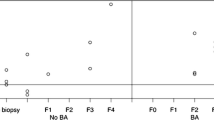Abstract.
Background. To evaluate the accuracy and utility of the triangular cord sign and gallbladder length in diagnosing biliary atresia by sonography.¶Materials and methods. Sixty fasted infants with cholestatic jaundice aged 2–12 weeks were examined sonographically using a 5–10 MHz linear array transducer, focusing on the triangular cord sign (as described by Choi et al. [1]), the gallbladder, and ducts. The triangular cord is defined as a triangular or tubular echogenic density seen immediately cranial to the portal vein bifurcation; it represents the fibrotic remnant of the obliterated cord in biliary atresia. The findings were blinded to blood chemistry, 99 mTc-DISIDA hepatobiliary scintigraphy, and liver biopsy. Diagnosis of biliary atresia was confirmed at surgery and histology. Non-biliary atresia infants resolved medically. Comparative charges of the various investigations was made.¶Results. Twelve infants had biliary atresia, and ten demonstrated a definite triangular cord. The two false-negatives had small or nonvisualized gallbladders. No false-positives were recorded. Gallbladder length ranged from 0–1.45 cm with a mean of 0.52 cm in biliary atresia compared to a mean of 2.39 cm in nonbiliary atresia infants. 99 mTc-DISIDA hepatobiliary scintigraphy showed no excretion (false-positive) in 23 % of nonbiliary atresia cases. Scintigraphy and liver biopsy charges were 2 and 6 times that of sonography, respectively.¶Conclusion. The triangular cord sign and gallbladder length together are noninvasive, inexpensive, and very useful markers for biliary atresia.
Similar content being viewed by others
Author information
Authors and Affiliations
Additional information
Received: 26 May 1999/Accepted: 28 July 1999
Rights and permissions
About this article
Cite this article
Tan Kendrick, A., Phua, K., Ooi, B. et al. Making the diagnosis of biliary atresia using the triangular cord sign and gallbladder length. Pediatric Radiology 30, 69–73 (2000). https://doi.org/10.1007/s002470050017
Issue Date:
DOI: https://doi.org/10.1007/s002470050017




